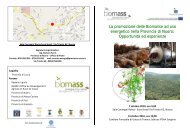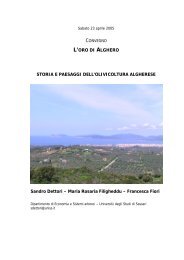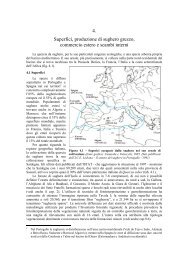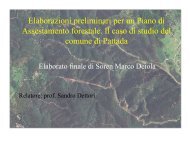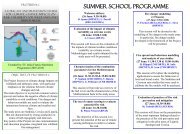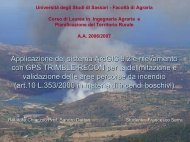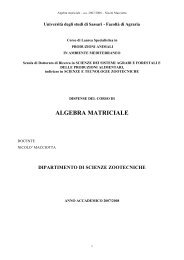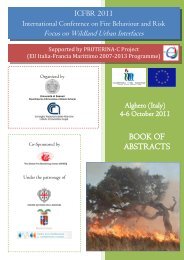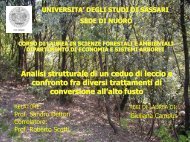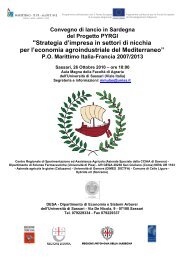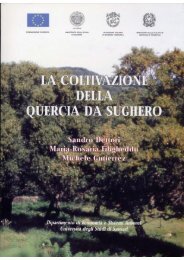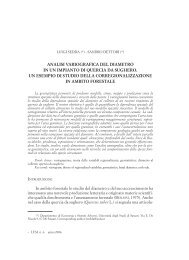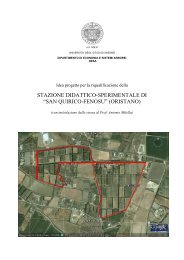Germogliamento e radicazione di talee di vite - Dipartimento di ...
Germogliamento e radicazione di talee di vite - Dipartimento di ...
Germogliamento e radicazione di talee di vite - Dipartimento di ...
You also want an ePaper? Increase the reach of your titles
YUMPU automatically turns print PDFs into web optimized ePapers that Google loves.
had a more coloured rind and total soluble solids content in the juice. The influence of fruit<br />
characteristics on the harvesting operations was <strong>di</strong>scussed.<br />
Keywords:Citrus, orange, varieties, harvesting, fruit <strong>di</strong>stribution.<br />
Poiché la conoscenza <strong>di</strong> alcuni aspetti legati al modo <strong>di</strong> fruttificare delle singole specie e<br />
cultivar può fornire utili in<strong>di</strong>cazioni in fase <strong>di</strong> organizzazione dei cantieri <strong>di</strong> raccolta, su alcune<br />
cultivar <strong>di</strong> arancio <strong>di</strong>ffuse in Sardegna (“Biondo Comune”, “Moro”, “Tarocco”, “Valencia”, e<br />
“Washington navel”) è stata valutata la <strong>di</strong>stribuzione della fruttificazione nell’ambito della chioma,<br />
attraverso la determinazione del numero dei frutti presenti in <strong>di</strong>versi settori della pianta sia in<br />
funzione dell’altezza (da 0 a 180 cm, e oltre i 180 cm), che della profon<strong>di</strong>tà (nei primi 50-100 cm - a<br />
seconda dell’età della pianta - e oltre), che dell’esposizione. Per le cultivar “Tarocco” e<br />
“Washington navel” le osservazioni sono state condotte su piante <strong>di</strong> <strong>di</strong>versa età e in zone <strong>di</strong> coltura<br />
<strong>di</strong>fferenziate, mentre per le altre sono stati esaminati alberi in piena produzione e in un unico<br />
ambiente. I risultati hanno messo in evidenza che sulle piante giovani si è avuta, rispetto alle piante<br />
in piena produzione, una notevole percentuale <strong>di</strong> frutti anche all’interno della chioma. Nelle piante<br />
adulte, infatti, la produzione è risultata in preponderanza <strong>di</strong>stribuita nella fascia periferica della<br />
chioma. Si è rilevato, inoltre, che mentre nelle piante giovani la produzione era pressoché tutta<br />
concentrata nei primi 180 cm <strong>di</strong> altezza, in quelle adulte, soprattutto nelle cultivar “Moro” e<br />
“Tarocco”, oltre il 50% dei frutti era <strong>di</strong>stribuito ad un’altezza superiore a 180 cm. Per quanto<br />
riguarda l’esposizione, si è osservato che la metà chioma esposta a SO e SE presentava una<br />
produttività nettamente superiore alla corrispondente metà esposta a NO e NE. I frutti situati<br />
all’interno della chioma sono risultati più piccoli, meno colorati, con buccia più sottile e maggior<br />
contenuto in succo, ma minor tenore zuccherino e maggiore aci<strong>di</strong>tà. I frutti prodotti nella parte alta<br />
della pianta, infine, erano <strong>di</strong> maggiori <strong>di</strong>mensioni, più colorati e con un maggior contenuto <strong>di</strong> soli<strong>di</strong><br />
solubili totali. Tutti i dati sono stati <strong>di</strong>scussi in merito, soprattutto, alla loro influenza sulla raccolta<br />
meccanizzata.<br />
Parole chiave: agrumi, arancio, varietà, raccolta, <strong>di</strong>stribuzione della fruttificazione.<br />
-------------------------------------------------------------------<br />
Meccanizzazione della potatura e della raccolta degli agrumi<br />
Pruning and harvesting mechanisation in Citrus<br />
Deidda P., Dettori S., et al.<br />
Progetto Finalizzato per la Meccanizzazione Agricola, quaderno <strong>di</strong> sint. n° 20, CNR, 1981<br />
A detailed report on the results of a coor<strong>di</strong>nated research programme devoted to several<br />
aspects of pruning and harvesting mechanisation in Citrus is given. After a brief introduction on the<br />
Italian Citrus industry and related aspects, the results of the research carried out on several areas of<br />
Calabria, Sicily and Sar<strong>di</strong>nia are reported. The performance of several types of pruning equipment<br />
was influenced by tree structure, biomass removed and the length of the rows. It was shown that a<br />
vigorous growth was induced by mechanical pruning, but no appreciable production change was<br />
observed. A far as mechanical harvesting is concerned the results showed that the use of single -<br />
man or multi-man positioners associated with bins could give <strong>di</strong>fferent performances. The best<br />
results were obtained with a single-man positioner associated with 220 Kg bins.<br />
Keywords: Citrus, pruning, harvesting, mechanisation.<br />
26



